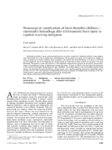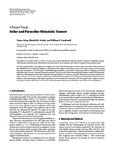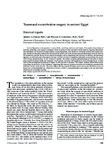|
|
Creator | Title | Description | Subject | Date |
| 276 |
 |
Couldwell, William T. | Hemorrhagic and nonhemorrhagic Rathke cleft cysts mimicking pituitary apoplexy | Object. Rathke cleft cysts (RCCs) are infrequently symptomatic, and apoplexy is one of the most unusual presentations. Only a few cases of apoplexy associated with RCCs have been reported, and their clinical, imaging, surgical, and pathological features are poorly understood. In the cases that have ... | | 2008-01-01 |
| 277 |
 |
Couldwell, William T. | Metabolic syndrome: what neurosurgeons should know | The term metabolic syndrome, first introduced in 1988, has evolved in concept since that time. While the strict definition is subject to ongoing debate, the syndrome generally involves glucose intolerance, obesity, dyslipidemia and high blood pressure, which increase the risk of developing cardiovas... | | 2008-01-01 |
| 278 |
 |
Schmidt, Meic H. | Rod derotation techniques for thoracolumbar spinal deformity | OBJECTIVE: The operative correction of scoliosis requires multiple intraoperative techniques and tools to achieve an adequate result. Frequently, multiple methods are used to accomplish this, such as rod cantilever techniques, in situ bending, Smith-Petersen and pedicle subtraction osteotomies, clo... | | 2008-01-01 |
| 279 |
 |
Couldwell, William T. | OR noise: the potential for hearing loss | With the use of the electric or air-powered drill in cranial or spinal procedures comes the potential for hearing loss among operating team members. Exposure to loud noise can result in sensorineural hearing loss, and this loss is a function of sound pressure levels and duration of exposure. Much r... | | 2008-01-01 |
| 280 |
 |
Couldwell, William T.; Gillespie, David L.; Jensen, Randy L. | Novel model of intracranial meningioma in mice using luciferase-expressing meningioma cells | Object. Meningioma research has been hindered by the inability to sequentially measure intracranial tumor growth in a cost-effective, efficient manner. Recently, the luciferase gene has been transfected into cancer lines to obtain cells that express the luciferase enzyme, which oxidizes luciferin in... | | 2008-01-01 |
| 281 |
 |
Schmidt, Meic H. | Minimally invasive thoracoscopic resection of paraspinal neurogenic tumors: technical case report | OBJECTIVE: The posterior mediastinum is a common location for benign neurogenic tumors. They are frequently asymptomatic but can present with local compressive or neurological symptoms. METHODS: Thoracoscopy is used increasingly over posterolateral thoracotomy for the removal of these lesions. RES... | | 2008-01-01 |
| 282 |
 |
Couldwell, William T. | Comment on Kitano, M., et al.: Subdural patch graft technique for watertight closure of large dural defects in extended transsphenoidal surgery | Ahn and Kim demonstrate a suturing technique to close dural defects after transsphenoidal and extended transsphenoidal approaches. The technique entails a specifically designed forceps to cinch the knot down in the depths of the field. The Author's used the technique in 21 consecutive patients (16 e... | Transsphenoidal surgery; CSF leaks | 2009 |
| 283 |
 |
Dailey, Andrew T. | Magnesium efficacy in a rat spinal cord injury model | Object. Magnesium has been shown to have neuroprotective properties in short-term spinal cord injury (SCI) studies. The authors evaluated the efficacy of magnesium, methylprednisolone, and magnesium plus methylprednisolone in a rat SCI model. Methods. A moderate-to-severe SCI was produced at T9-10 ... | Methylprednisolone; Spinal cord injury; Rat model | 2009 |
| 284 |
 |
Dailey, Andrew T.; Brodke, Darrel S. | Timing and influence of MRI on the management of patients with cervical facet dislocations remains highly variable: a survey of members of the Spine Trauma Study Group | Background: Traumatic cervical facet dislocations are potentially devastating injuries. Magnetic resonance imaging (MRI) is an excellent means of assessing ligamentous disruption, disk herniation, and compression of the neural elements. However, despite an improved understanding of these facet dislo... | Cervical facet dislocations; MRI; Spine Trauma Study Group | 2009 |
| 285 |
 |
Couldwell, William T.; Harnsberger, H. Ric | Oronasopharyngeal chordomas | Background: Chordomas are rare tumors derived from notochordal remnants. The authors report on a series of three cases of primary familial oronasopharyngeal chordomas treated at our institution. Methods: A retrospective chart review was completed of the three cases of primary familial oronasopharyng... | Oronasopharyngeal; Chordoma; Pharynx; Notochord; Transoral; Skull base | 2009 |
| 286 |
 |
Dailey, Andrew T.; Brodke, Darrel S. | Utility of helical computed tomography in differentiating unilateraland bilateral facet dislocations | Objective: Diagnosis of cervical facet dislocation is difficult when relying on plain radiographs alone. This study evaluates the interobserver reliability of helical computed tomography (CT) in the assessment of cervical translational injuries, correlates the radiographic diagnosis with intraoper... | Facet dislocations; Helical computed tomography; Spinal trauma | 2009 |
| 287 |
 |
Kestle, John R. W.; Simon, Tamara Danielle | Infection rates following initial cerebrospinal fluid shunt placement across pediatric hospitals in the United States | Object. Reported rates of CSF shunt infection vary widely across studies. The study objective was to determine the CSF shunt infection rates after initial shunt placement at multiple US pediatric hospitals. The authors hypothesized that infection rates between hospitals would vary widely even after ... | Shunt placement; Pediatric neurosurgery | 2009 |
| 288 |
 |
Dailey, Andrew T. | Thoracolumbar spine trauma classification: the Thoracolumbar Injury Classification and Severity Score system and case examples | Object. The aim of this study was to review the Thoracolumbar Injury Classification and Severity Score (TLICS) and to demonstrate its application through a series of spine trauma cases. Methods. The Spine Trauma Study Group collaborated to create and report the TLICS system. The TLICS system is re... | Thoracolumbar spine trauma; Classification; Thoracolumbar injury; TLICS; Spine Trauma Study Group; Thoracolumbar Injury Classification and Severity Score | 2009 |
| 289 |
 |
Schmidt, Meic H. | Assessment of the reliability of the Enneking and Weinstein-Boriani-Biagini classifications for staging of primary spinal tumors by the spine oncology study group | Despite advances in the treatment of primary spinal tumors in recent years, the with respect to the feasibility of oncologically appropriate surgical treatment and the selection of the optimal surgical approach. These tumors are relatively rare, comprising 11% of all primary musculoskeletal tumors a... | | 2009-01-01 |
| 290 |
 |
Couldwell, William T. | Use of the h index in neurosurgery | Object. Assessing academic productivity through simple quantification may overlook key information, and the use of statistical enumeration of academic output is growing. The h index, which incorporates both the total number of publications and the citations of those publications, has been recently ... | | 2009-01-01 |
| 291 |
 |
Couldwell, William T. | Fenestration of the oculomotor nerve by a duplicated posterior cerebral artery and aneurysm | The authors report a case of a posterior cerebral artery aneurysm arising from an aberrant arterial branch that was found to be splitting the oculomotor nerve. This 63-year-old man presented with headaches, and CT imaging revealed subarachnoid hemorrhage primarily within the basilar cisterns. Formal... | | 2009-01-01 |
| 292 |
 |
Couldwell, William T. | Unruptured posterior communicating artery aneurysm presenting with gustatory seizures and temporal lobe edema | Unruptured cerebral aneurysms presenting with seizures are unusual. We describe a case of a growing middle cerebral artery aneurysm presenting with gustatory seizures with magnetic resonance imaging showing peri-aneurysmal edema. This case is the first to show temporal lobe edema associated with inc... | Seizure; Brain edema; PCOM | 2009-04 |
| 293 |
 |
Dailey, Andrew T.; Schmidt, Meic H.; Apfelbaum, Ronald I. | Anterior fixation of odontoid fractures in an elderly population | Object. Fractures of the odontoid process are the most common fractures of the cervical spine in patients over the age of 70 years. The incidence of fracture nonunion in this population has been estimated to be 20-fold greater than that in patients under the age of 50 years if surgical stabilizatio... | Odontoid fractures; Elderly population; Anterior fixation | 2010 |
| 294 |
 |
Bisson, Erica F. | Management of distraction injury of the lumbosacral junction with unilateral perched facet | Background: Traumatic unilateral facet dislocation without fracture is an uncommon injury of the lumbosacral junction. We describe a case of a unilateral perched L5-S1 facet causing axial back pain and radiculopathy provoked by motion. ... | Spine surgery, Facet dislocation, operative management, trauma, neurosurgery | 2011-01-04 |
| 295 |
 |
Couldwell, William T. | Ganglion cyst of the temporomandibular joint with intracranial extension in a patient presenting with seventh cranial nerve palsy | Ganglion cysts arising from the temporomandibular joint are rare entities that often present with swelling and minimal to no pain in the preauricular region. To the Author's? knowledge, a temporomandibular joint ganglion cyst occurring with acute facial nerve palsy and intracranial extension has ne... | | 2012 |
| 296 |
 |
Couldwell, William T. | The frontotemporal (Pterional) approach: an historical perspective | The frontotemporal, so-called "pterional" approach has evolved with the contribution of many neurosurgeons over the past century. It has stood the test of time and been the most commonly used transcranial approach in neurosurgery. In its current form, drilling the sphenoid wing as far down as the su... | | 2012-01-01 |
| 297 |
 |
Garber, Sarah | Neurosurgical complications of direct thrombin inhibitors - catastrophic hemorrhage after mild traumatic brain injury in a patient receiving dabigatran | Dabigatran etexilate is an oral anticoagulant that acts as a direct, competitive thrombin inhibitor. Large randomized clinical trials have shown higher doses of dabigatran (150 mg taken twice daily) to be superior to warfarin in terms of stroke and systemic embolism rates in patients with nonvalvula... | | 2012-01-01 |
| 298 |
 |
Couldwell, William T. | Sellar and parasellar metastatic tumors | The sellar and parasellar (SPS) region is a complex area rich in vital neurovascular structures a first manifestation of a systemic malignancy. Metastases to this region are rare; breast cancer is the most common source among those that metastasize to the SPS region. Ophthalmoplegia, headache, retro... | | 2012-01-01 |
| 299 |
 |
Couldwell, William T. | Transnasal excerebration surgery in ancient Egypt: Historical vignette | Ancient Egyptians were pioneers in many fields, including medicine and surgery. Our modern knowledge of anatomy, pathology, and surgical techniques stems from discoveries and observations made by Egyptian physicians and embalmers. In the realm of neurosurgery, ancient Egyptians were the first to elu... | | 2012-01-01 |
| 300 |
 |
Couldwell, William T. | Efficacy of clip-wrapping in treatment of complex pediatric aneurysms | Purpose: Pediatric aneurysms (PAs) are distinct from their adult counterparts with respect to typical location, aneurysm type, and known predisposing risk factors. Many strategies have been employed to treat PAs, but, although it has been used frequently in adults, clip-wrapping in pediatric patient... | | 2012-01-01 |

























